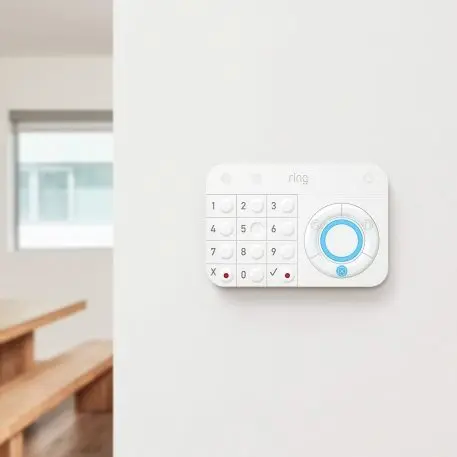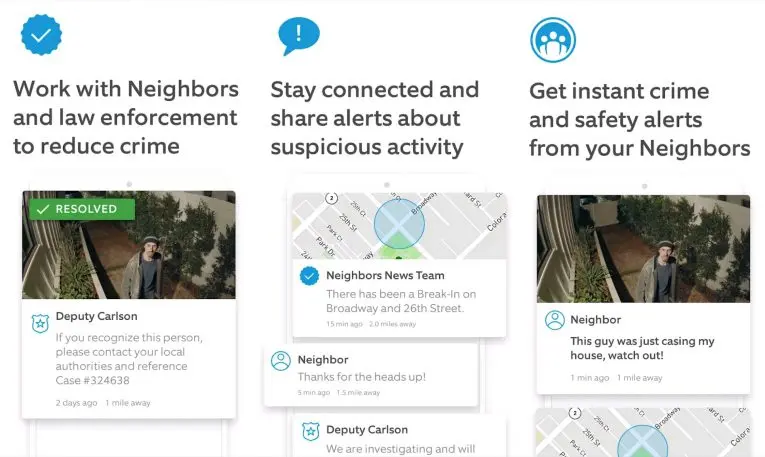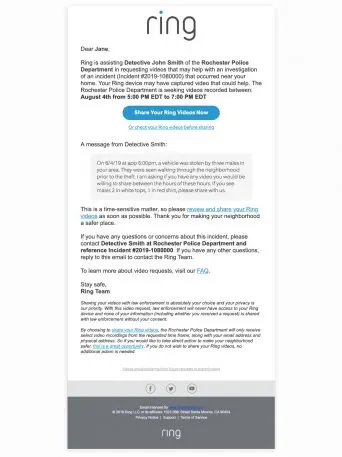For the past few months, I’ve been letting Ring—and, by extension, Amazon—monitor my house.
When no one’s home, the Ring Alarm system keeps watch through a system of contact and motion sensors, ready to send alerts to my phone—and, optionally, to a professional monitoring service—if the sensors detect an unwelcome presence. Meanwhile, Amazon’s Echo speakers provide extra protection, letting me arm and disarm the system by voice and listening for the sound of smoke alarms or broken glass.
If I wasn’t using a Ring Alarm system on loan from the company, it’s the kind of thing I might’ve already bought for myself—perhaps during Prime Day or the many other occasions when Amazon puts the product on deep discount. Even at a regular price of $199 for an entry-level kit, it undercuts competitors like Nest and ADT by hundreds of dollars, and it’s more reliable than cheaper do-it-yourself systems that lack cellular and battery backups. It is, in short, a great product, and it’s one that Ring CEO Jamie Siminoff tells me is central to the company’s future.
“We do believe it really is a core, foundational piece of our overall long-term vision and mission to protect and keep our neighbors safer,” Siminoff says in an interview, which Ring set up to discuss the company’s strategy around alarm systems.
At the same time, it’s hard to reconcile my appreciation for the Ring Alarm with my unease about the company behind it. Even as crime rates hit record lows, Ring has convinced millions of people to surveil their property through doorbell cameras, and it’s now helping police departments around the country ask residents for warrantless access to the footage. Meanwhile, Ring’s Neighbors app provides an open forum in which people can discuss threats—both real and perceived—in their communities, risking heightened paranoia over whatever their cameras are dredging up.
The Ring Alarm, despite all its virtues, is a natural extension of those efforts. If using Ring’s camera and Neighbors app puts you on edge, an alarm system is just the thing to restore peace of mind. But buying into that system feels unsettling, no matter how well it actually works.
Knowing when you’re home
Compared to a traditional security system, the most alluring aspect of the Ring Alarm is that it doesn’t feel like a huge commitment. The base price of $200 is pretty low for home security, and the $10 per month home monitoring service isn’t mandatory. Even without it, you’ll still get a blaring siren at home and alerts on your phone during a potential intrusion. (You even get a window sticker to ward off prospective burglars.)
Setting the system up isn’t much of a hassle, either. You have to connect the base station to Wi-Fi on your own, but all the other components are paired out of the box. All you have to do is mount the contact sensor to a door or window and figure out the best place to put the motion sensor.

“By delivering affordability, usability—having it as easy as it is—and then the peace of mind of what it does for you, I think all of these things together are why it’s doing so well in the market,” he says.
Ring isn’t just trying to sell alarm systems, though. It’s also hoping to build an ecosystem around them, with add-ons like smoke and carbon monoxide detectors, and tie-ins with other companies’ smart lights, door locks, and other devices under the “Works with Ring” program. Long-term, Siminoff envisions a platform that can work automatically on behalf of users, changing the state of the home based on whether they’ve armed or disarmed their systems.
It’s all part of a broader shift for the company, Siminoff says, away from a singular focus on reducing crime, and toward increasing safety overall. That mission is also what distinguishes Ring’s smart-home efforts from those of Amazon, which has built a broader platform around its Alexa voice assistant.
“There are things on my list that people have never done before in this area,” Siminoff says. “A big part of that innovation will come from things like the Ring Alarm having state [awareness], to be able to build these next-generation products and services that will make our neighbors safer.”
Pushing private surveillance
The smart-home nerd in me thinks all of this sounds great. The state of an alarm system is a pretty good proxy for whether its users are home or not, and from that bit of insight a lot of clever automations can spring forth. Ring’s strategy around home and away states reminds me of what Nest was building through its “Works with Nest” program, which languished after Google acquired the company in 2014. (Google is now trying to fold Nest’s previous integrations into its own “Works with Google Assistant” program, which presently revolves more around voice interaction.)
But at a time when tech companies are intent on locking you into their respective smart-home platforms, investing in any one of them requires a certain degree of trust. Personally, I’m wary of a company that quietly encourages police departments to help sell more doorbell cameras, coaches said departments on the best way to convince residents to turn over their camera footage without warrants, dictates what those departments should and shouldn’t say publicly, and wraps the details of those partnerships under confidentiality agreements. The overall picture is of a company that is pursuing growth at the cost of privacy, largely out of the public eye.
In its defense, Ring says that police can’t access any Ring footage without getting explicit permission from the camera owner every time, and that it doesn’t share customers’ information or exact location with police while passing along these requests. The idea is that police won’t know if a specific Ring camera owner has refused a request for footage. Still, Gizmodo recently reported that Ring had been sharing information on how many users rejected footage requests—a practice that Ring says it’s now abandoned—and that police have found their own ways to identify Ring users.

Ring seems to have realized that it can’t go on like this. After months of records requests and reporting on Ring’s activities by Vice Motherboard, CNet, Gizmodo, and Wired, among others, the company is making grander gestures toward transparency. It now publicizes the number and location of police partnerships it has around the country, and it now tells residents via its Neighbors app that these partnerships allow police to request doorbell camera footage. Eric Kuhn, the general manager of Neighbors, says that Ring will begin emailing users about these partnerships as well, rather than just sending out messages through Neighbors.
“We’ve tried to make it as transparent as possible,” says Kuhn. “We’ll continue to make it more transparent.”
Kuhn also acknowledges that confidentiality agreements with police departments are no longer tenable given that they’ll turn up in public records requests anyway. He claims that previous agreements demanding confidentiality were “boilerplate” and the result of standard industry practices.
“Those agreements will evolve over time, and that clause is, I think, one that is not really necessary,” he says.
Same fear, slicker package
While the Ring Alarm system runs parallel to the company’s doorbell camera business, it also arguably completes a virtuous cycle that starts with people surveilling their property. Thanks to Ring’s Neighbors app, people who own Ring doorbell cameras can share their footage and ask others in their community for advice. Ring, in turn, has used the app as marketing fodder, sharing footage of alleged criminals in Facebook ads and hiring editors to create neighborhood crime alerts. See enough of these alerts, and you might start thinking that an alarm system is essential.

“We’ve always tried to use real examples of what we’ve done without trying to hype the crime up to do that,” Siminoff says.
But just because the crimes are real doesn’t mean that people are getting an accurate sense of the danger level in their communities. The problem with an app like Neighbors is that it inherently focuses on crime and other negative events, rather than providing a more balanced view of what’s happening around them. This could further convince people that crime is more prevalent than it actually is, in the same way that crime-heavy local news reporting makes people feel disproportionately threatened.
Ring’s Eric Kuhn argues that the Neighbors app highlights more than just crime, pointing to posts about finding lost pets, returning lost items, or—in one case—a neighbor helping a family escape a house after it caught fire. He also says Ring has tried to dial down paranoia with new guidelines that users must agree to before posting. Ring has been encouraging users to focus more on behavior, rather than individuals or their appearance, and its guidelines now explicitly forbid racial profiling. Every video post also requires approval by a human moderator.

Even so, Ring will not disclose the proportion of posts in Neighbors that aren’t crime-related, and the app store listings for Neighbors lay bare the app’s primary purpose: “Stay connected and share alerts about suspicious activity,” says one promotional image. “Work with Neighbors and law enforcement to reduce crime,” says another. Lost pets and personal belongings don’t get a mention.
Doing the right things
Partway through my conversation with Siminoff, he said something that stuck out to me. We were discussing competition with other alarm systems, and he began talking about how Ring is ultimately guided by what its customers want.
“If we make our neighbors’ lives better in their homes, make their neighborhood safer, they will reward us with their money,” he says. “People don’t buy a Ring product, they reward us by taking that product into their home because they know that what they’re doing is going to make their lives better.”

Because Ring isn’t getting blowback from customers, it can easily overlook the downsides of what it’s doing. This is the same pattern we’ve seen with other tech companies such as Facebook and YouTube, whose ever-increasing revenues and engagement seemingly blinded them to their products’ negative implications. In the case of the Ring Alarm, the push to provide peace of mind could paradoxically be creating more anxiety about crime and injury, all in service of turning what could be a niche business into a mass-market product, worthy of a tech giant like Amazon.
I’m reminded of this every week, when Ring delivers a local “crime report” to my phone. Looking over the map of my area reveals all kinds of threats, from theft to assault, suggesting that the Ring Alarm would be money well spent. Only upon closer inspection do I notice that the report casts far too wide a geographic net. Zooming in on my neighborhood and its surrounding areas reveals that there’s really nothing to worry about.
Recognize your brand’s excellence by applying to this year’s Brands That Matter Awards before the early-rate deadline, May 3.
